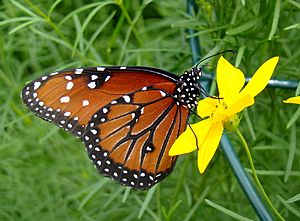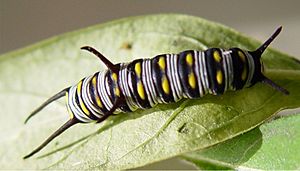Queen (butterfly) facts for kids
Quick facts for kids Queen |
|
|---|---|
 |
|
| Scientific classification | |
| Kingdom: | |
| Phylum: | |
| Class: | |
| Order: | |
| Family: | |
| Subfamily: | |
| Tribe: | |
| Genus: | |
| Species: |
D. gilippus
|
| Binomial name | |
| Danaus gilippus (Cramer, 1775)
|
|
The Queen (Danaus gilippus) is a type of butterfly. It belongs to the family Nymphalidae. You can find it in North America, Central America, and South America.
Contents
What the Queen Butterfly Looks Like
The top side of the Queen butterfly's wings is a dark reddish-brown color. Its wings have black borders. Male Queen butterflies have a special spot on each of their back wings. This spot releases scents to attract females. The underside of the wings is also reddish-brown. These wings also have black borders with white spots. The back wings have black veins, which are like lines on the wing.
How Butterflies Protect Themselves: Mimicry
The Queen butterfly is part of a group of butterflies that look very much alike. This is called a mimicry ring. In places where these butterflies live together, they often have similar appearances.
For example, the Monarch (Danaus plexippus) is orange with thick black veins. The Viceroy (Limenitis archippus) is smaller and also has thick black veins. It has a black band across its back wing. The Soldier (Danaus eresimus) has thin black veins. On the underside of its back wing, it has a row of light, square-shaped spots.
The Monarch's Special Defense
Monarch butterflies taste bad and are poisonous. This is because they have a chemical called cardenolide. This chemical can slow down the heart of animals that try to eat them. Monarch caterpillars get this chemical when they eat milkweed plants.
When a Monarch caterpillar turns into a butterfly, it stops eating milkweed. But it still keeps the chemical in its body. The butterfly's bright orange and black wings act as a warning. This is called warning coloration. If a bird tries to eat a Monarch, it will get sick and vomit. After this bad experience, the bird learns not to eat Monarchs. It also learns to avoid other butterflies that look similar.
The Viceroy and Batesian Mimicry
The Viceroy butterfly looks a lot like the Monarch. However, it does not have the milkweed poison in its body. Birds that have had a bad experience eating a Monarch usually won't eat a Viceroy either. This is an example of Batesian mimicry. In this type of mimicry, a harmless animal looks like a harmful one to avoid predators.
The Queen and Müllerian Mimicry
The Queen butterfly is one of many insects that gets its chemical defenses from the plants it eats. Most of the toxic chemicals that make Queens taste bad to predators come from the plants their caterpillars feed on.
The Queen butterfly shares a Müllerian mimicry relationship with the Monarch. In Müllerian mimicry, two or more harmful species look alike. This helps predators learn to avoid them faster. However, how poisonous the Queen butterfly is can change a lot in different areas where it lives. This means that even in small local areas, the way mimicry works can be different.
When the Queen Butterfly Flies
You can see the Queen butterfly all year long in Texas, Arizona, and southern Florida. In northern Florida, they are seen from February to December. In southern California and southern Nevada, you can spot them from April to November.
Where the Queen Butterfly Lives
This butterfly likes open spaces. You can find it in open woodlands, fields, deserts, marshes, and along the edges of forests.
Life Cycle
The female Queen butterfly lays her eggs one by one. She places them on the leaves, stems, and flowers of the host plant. A host plant is the plant that the caterpillar will eat. The egg is pale green.
The caterpillar has yellow and black bands. It has three pairs of black body extensions. The first pair is near its head. The second pair is on its middle body (thorax). The third pair is near the end of its body.
The chrysalis (the pupa stage) is green with gold spots. It also has a black and gold band on its lower body (abdomen). It looks very similar to a Monarch's chrysalis. Queen butterflies usually have three or more broods (groups of offspring) each year.
Host Plants
Here is a list of plants that the Queen caterpillar feeds on:
- Asclepias albicans - White-stem Milkweed
- Asclepias amplexicaulis - Clasping Milkweed
- Asclepias asperula - Antelope Horns
- Asclepias curassavica - Scarlet Milkweed
- Asclepias erosa - Desert Milkweed
- Asclepias fascicularis - Narrow-leaf Milkweed
- Asclepias humistrata - Sandhill Milkweed
- Asclepias nivea - Caribbean Milkweed
- Asclepias subulata - Rush Milkweed
- Asclepias tuberosa - Butterfly Weed
- Calotropis procera - Apple of Sodom
- Cynanchum angustifolium - Sand Vine
- Matelea carolinensis - Maroon Carolina Milkvine
- Matelea hirsuta
- Sarcostemma clausum - White Vine
- Sarcostemma cynanchoides - Vining Milkweed
- Sarcostemma hirtellum - Rambling Milkweed
Images for kids
-
Queen butterfly feeding on Funastrum cynanchoides, Tucson, AZ






